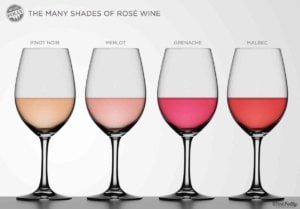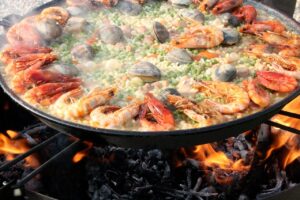
You know your red and white wine, but now it’s time for understanding rose wine. Curious just what the fuss is all about with rose wine? Check out our quick facts and easy guide below!
What is rose wine?
If white wine is made from white grapes and red wine is made from red ones, then we can tell you for a fact that rosé wine is not made from pink grapes. Because there is not such thing as pink grapes!
Rose wine also has nothing to do with the flower, rose. It’s also known as Rosé wine with a French pronunciation, which means pinkish.

Rose is made from red or purple grapes, and it is somewhat between white wine and red wine. The color is created due to skin contact or maceration, the process of soaking the skins and juice together which involves coloration as the skin bleeds into the juice.
In rose wine, the maceration results in a pinkish color, since the skins are removed after only brief contact. As a result, the juice is not red enough to warrant the wine to be classified as red wine.
Other than the maceration method, rose wine can also be made with Bled Method which is very popular in Napa and Sonoma. This involves “bleeding” the juice of red wine grapes to produce rose wine with red wine’s intensity. This is usually rare and not very common.
Another method is blending method, which is basically mixing together a vat of white and red wine together to produce rose wine. Another uncommon method compared to maceration (and not always approved by the wine community), usually it doesn’t take much red wine to dye a white wine pink.
Understanding its profile
Rose wine is best served chilled and it’s the perfect one for outdoor drinking, especially on a hot day.
White wine and rose are often early favorites for new wine drinkers, they are fruity, usually sweeter and very refreshing when served cold. On the other hand, it takes time to acquire the taste for more tannic and complex red wines.
The flavors of rosé wines tends to be more subtle versions of their red wine varietal counterparts. The fruit flavors lean towards strawberry, cherry, and raspberry with some citrus and watermelon presenting on a regular basis. As for the tannins, rose wine has lower tannins compared to red wine.
Understanding the shades of rose wine

Several types of rose wine you can find in the market are:
- Dry Rose Wine
The most common style produced today around the world, including in France and Spain. The no sweet taste is derived from 2-3 different grapes varieties that are blended together, usually Syrah, Pinot Noir, Cinsault, Grenache etc.
- Sweet Rose Wine
Traditionally sweet rose wines aka no sugar added into the alcohol includes: White Zinfandel, White Merlot and Pink Moscato.
How to buy rose wine
Just a quick tip for your buying reference when it comes to rose wine:
- Pay attention to the color.
Deeper colored aged roses are less common and less traditional. These are richer with full body that are more similar to red wine than a white. So if you’re new to the world of wine, do sample a lighter shade that is ultra light and ultra crisp.
- Grape Varietals
If grape varietals confuse you, don’t worry since rose wine loses a lot of flavors in the process of its making. Pay little attention to the grape varietals, and ask your seller for more guidance with wine.
- Aroma & Age
Look for appetising aroma, with a smell and fresh taste even at room temperature. As for the age, stick to the most recent vintage which should also smell fresh with just the right flavors.
Last but not least in understanding rose wine, visit LuxoFood to get your fill of quality food ingredients and beverages, along with other items to go with your rose wine!



